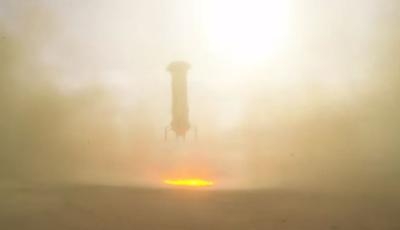Wed, Nov 25, 2015
Only Time Will Tell If The Booster Is Truly Reusable
News/Analysis By Wes Oleszewski
On November 23, 2015 Blue Origin achieved a first in rocketry and spaceflight history when their New Shepard launch vehicle successfully delivered a payload across the official boundary of space and then returned to Earth to land upright under rocket power.

Working in near secrecy and well out of sight of the media Blue Origin has netted engineering results that gave the company the opportunity to reach this unique milestone. While landing a large rocket powered vehicle upright had been done in the past both with the McDonnell Douglas DC-X in the 1990s and with SpaceX’s Grasshopper more recently, neither vehicle was designed to reach space with a payload. SpaceX has tried twice to land the first stage of its Falcon 9 launch vehicle and failed each time. Blue Origin also failed in its first attempt to land the New Shepard booster on April 29, 2015. Yet the bugs seem to be fully worked out of their system this time.
New Shepard landed just 4.5 feet from the dead center of the target at a touchdown speed of just 4.4 miles per hour. This after boosting the vehicle’s spacecraft in a high altitude toss to an altitude of 329,839 feet, or 100.5 Km which is just beyond the internationally recognized boundary of “space.” The flight was launched from Blue Origin’s secluded West Texas launch site shortly after the hour of noon Eastern time.
In spite of scores of SpaceX fans who have scoffed at Blue Origin’s ability to achieve the historic milestone that their favored space company has failed to meet, the fact is that this is a spaceflight first. At this moment Blue Origin has in their possession a flight ready booster that has been flown and can now be flown again. That task was accomplished without a legion of internet fans, without a huge influx of NASA funds and without a doughnut wall.

Yet the questions now remain, how re-useable will be this re-usability? Will the New Shepard vehicles be able to safely and reliably fly passengers beyond the space boundary over and over to the point where the company can actually earn money? Or, will the system suffer the same myth of re-usability that the Space Shuttle experienced? Granted, the sub-orbital system is far less complex in countless ways including fuels and operational environment, but there are always factors that sap the bottom line in any flying venture.
For now, however, the team at Blue Origin has made spaceflight history and no one can ever take that away from them. I only wish that they would have let us all watch it live rather than telling us afterward in Soviet-like space tradition.
(Images provided by Blue Origin)
More News
Also: 1st-Ever Space Crime Was a Fraud, IAE Buys Diamonds, Kennon Bows Out, Perseverance Rover An interesting moment came about this past Sunday as ANN CEO, Jim Campbell, noted tha>[...]
Have A Story That NEEDS To Be Featured On Aero-News? Here’s How To Submit A Story To Our Team Some of the greatest new stories ANN has ever covered have been submitted by our>[...]
From 2023 (YouTube Edition): Deviation from the Historical Mean Racine, Wisconsin-based DeltaHawk is a privately-held manufacturer of reciprocating engines for aircraft and hybrid >[...]
Smoke Began Entering The Cockpit During The Landing Flare, And Then The Pilot Noticed Flames On The Right Side Of The Airplane Analysis: The pilot reported that about 30 minutes in>[...]
Remote Communications Outlet (RCO) An unmanned communications facility remotely controlled by air traffic personnel. RCOs serve FSSs. Remote Transmitter/Receivers (RTR) serve termi>[...]
 Airborne 11.24.25: ANN's 30th!, Starships V3 Booster Boom, Earhart Records
Airborne 11.24.25: ANN's 30th!, Starships V3 Booster Boom, Earhart Records ANN FAQ: Submit a News Story!
ANN FAQ: Submit a News Story! Classic Aero-TV: DeltaHawk Aero Engine Defies Convention
Classic Aero-TV: DeltaHawk Aero Engine Defies Convention NTSB Final Report: Glasair GlaStar
NTSB Final Report: Glasair GlaStar ANN's Daily Aero-Term (11.22.25): Remote Communications Outlet (RCO)
ANN's Daily Aero-Term (11.22.25): Remote Communications Outlet (RCO)




